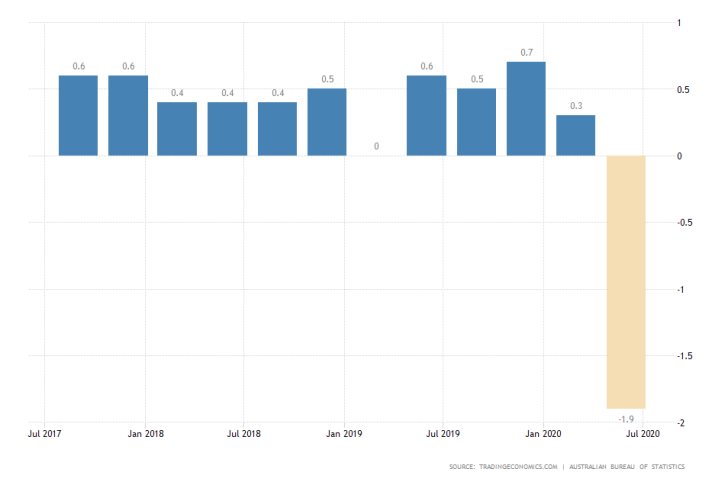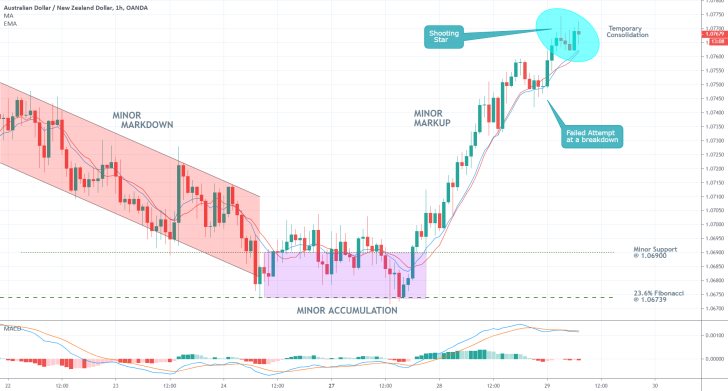
Earlier today, the Australian Bureau of Statistics released downbeat inflationary numbers for the fiscal quarter ending in June. It was revealed that the Consumer Price Index has decreased to negative 1.9 per cent from 0.3 per cent the previous quarter.
Although the findings of the economic report marginally exceeded the initial market expectations, which were projecting a contraction to negative 2.0 per cent, the harmful impact of the coronavirus fallout has driven the Australian economy into deflation.

Since the beginning of the coronavirus fallout in early 2020, Australia became one of the hardest-hit advanced economies due to its particular organisation. Its economy is massively dependent on uninterrupted trade with its biggest partner – China.
After the global supply chains were jolted in February, trade between the two countries became strained, which subsequently led to Australia's current predicaments, exacerbated by this weakened price stability.
The tentative global recovery during the second quarter cushioned some of those economic strains on Australia, which led to a significant rally for the Australian dollar. The Aussie picked up from historical lows and advanced against most other majors over the last few months.
This trend, however, is now threatened by recent developments, as we argued in our latest analysis of the AUDNZD pair. Surges in COVID-19 cases in Australia, as well as fears over a second wave globally, would impede this fragile recovery, potentially even lead to a new significant downturn.
All underlying factors seem to be signalling the same likely outcome for the Aussie. Weakened price stability from muted inflationary pressures coupled with the accelerating pandemic would very likely prompt a new scramble for safe-havens.
This trend, which was already observed in the wake of the pandemic, would cause the demand for the Aussie to wane in favour of lower-risk securities.
Nevertheless, shorter-term bias looks different. As can be seen on the hourly chart below, the AUDNZD continues to be developing its latest uptrend, which was commenced yesterday.
The shooting star candle could be interpreted as an early signal of a potential trend reversal, which is somewhat supported by the reading of the MACD indicator. The underlying momentum remains ostensibly bullish, but it does not appear to be rising anymore.
At any rate, traders should not rush to sell the pair More robust bearish indications would come when the price action manages to break down below the 10-day MA (in blue) and the 10-day MA (in red).

Trendsharks Premium
Gold is undergoing a correction, as investors take profits to offset losses from falling stock prices, impacting their margins. However, we anticipate a renewed wave of [...]
The Swiss stock market index is mirroring its global counterparts, such as Germany 40 and US100, experiencing a sharp decline following the announcement of new [...]
We’re analyzing the weekly chart to grasp the broader market trend. Over the past three years, the US30 index has surged by 17,000 points, often resembling a nearly straight [...]
Over the past week, the DAX has experienced a sharp decline, plunging by an astonishing 3,400 points. This downward movement is not isolated, as its international counterparts, such as the UK100 and US100, are also facing significant [...]
EURUSD recently formed a double top at 1.0930, signaling a potential trend reversal, and has since begun a correction. After a 600-pip rally since early March, a pullback at this stage is both expected and healthy. Given these conditions, we are placing a [...]
Since early March, EURJPY has surged nearly 1,000 pips, providing us with several excellent trading opportunities. However, as the rally matures, many early buyers are beginning to take profits, leading to a noticeable slowdown in the uptrend. On Friday, the pair formed a [...]
The AUDJPY currency pair continues to be dominated by bullish momentum, as multiple golden cross patterns reaffirm the strength of the ongoing uptrend. Despite this, we are witnessing a much-needed [...]
The EURAUD currency pair appears to be undergoing a trend reversal, signaling a potential shift in market direction. A notable technical development is the formation of a Death Cross on the chart, a widely recognized bearish indicator that typically suggests a [...]
After securing an impressive 200-pip profit last week, the EURJPY currency pair is now undergoing a southward correction, retracing some of its recent gains. Despite this temporary pullback, the Golden Cross remains intact, reinforcing our view that the overall trend continues to be [...]
The appearance of a Golden Cross in Silver strengthens our analysis that the metal is currently in a strong uptrend, indicating further bullish momentum in the market. This technical pattern, where the short-term moving average crosses above the [...]
This trade presents a considerable level of risk and can be classified as an opportunistic move based on recent price action. The GBPUSD currency pair has experienced a substantial bullish rally, surging by nearly 500 pips in a strong upward movement. However, after this extended period of appreciation, the pair is showing signs of a potential [...]
The anticipated Death Cross on the SMI20 appears to be failing as price finds strong support at the 23% Fibonacci retracement level. After testing this area, the index has shown bullish strength, printing several large green candles, signaling an increase in [...]
A Golden Cross has just appeared on the USDJPY chart, signaling a potential bullish move. This technical pattern occurs when the 20 period moving average crosses above the 60 period moving average, a widely recognized indication of increasing [...]
After 2 months of a down trend, we finally see some indications of price recovery for Oil. The golden cross, a historic buy signal, supports this [...]
For the past month, the German DAX40 has experienced a remarkable 10% surge, reflecting strong bullish momentum. Despite ongoing market volatility and frequent pullbacks, every dip continues to attract fresh buyers, reinforcing the [...]
Oil continues its downward trajectory, despite occasional pullbacks. The overall trend remains bearish, reinforced by multiple Death Cross patterns, a classic sell signal indicating further weakness. Adding to this bearish outlook, the critical [...]
Over the past few days, gold has experienced a sharp decline of more than $100. This downturn can be attributed in part to traders securing profits to manage their margins, which are under strain due to the significant drop in major indices. Currently, gold has fallen below the [...]
The NASDAQ 100 index is showing strong bullish momentum, as evidenced by the formation of a Golden Cross on the chart. This classic buy signal occurs when the short moving average crosses above the long term moving average, suggesting that upward momentum is [...]
The EURAUD currency pair has encountered a significant resistance level, failing to break above the critical 61% Fibonacci retracement level. This suggests that bullish momentum is weakening, reinforcing the case for a potential downward move. Given this technical setup, we favor entering a [...]
The UK100 is experiencing a remarkable rally! Over the past few weeks, the British stock market index has surged nearly 800 points. Each minor dip has attracted more buyers, fueling the bullish momentum. However, since last week, we’ve observed a slight [...]




















